Introduction: A Polymath of the Scottish Enlightenment

Alexander Nasmyth stands as a pivotal figure in the history of Scottish art, celebrated primarily as the "Father of Scottish Landscape Painting." Born in Edinburgh on September 9, 1758, and dying there on April 10, 1840, his long and productive life spanned a period of immense cultural, intellectual, and artistic change. While his legacy is most firmly rooted in his evocative depictions of Scotland's natural and man-made environments, Nasmyth was a true polymath of the Scottish Enlightenment era. His talents extended beyond the canvas to encompass portraiture, architectural design, engineering innovation, and influential art education. His circle included poets like Robert Burns, fellow artists such as Allan Ramsay and Sir David Wilkie, and patrons who shaped the nation's progress. Understanding Nasmyth requires appreciating not only his artistic output but also his engagement with the broader currents of his time, making him a fascinating subject for art historical study.
Early Life and Artistic Awakening in Edinburgh
Alexander Nasmyth entered the world in Edinburgh's historic Grassmarket district. His father, Michael Nasmyth, was a respected builder and carpenter, providing a background that perhaps instilled in the young Alexander an appreciation for structure and design. The family, though based in the city, held connections to land ownership in the Lowlands. His formal education took place at the prestigious Royal High School, followed by studies at the Trustees' Academy (a precursor to the Edinburgh College of Art), which aimed to improve the quality of design in Scottish manufacturing but also provided foundational art training.
Alongside his academic pursuits, Nasmyth gained practical experience through an apprenticeship with a coach painter, likely named Crichton. This work involved decorating carriage panels, a craft demanding precision and decorative skill. It was during this period, around the age of sixteen, that his artistic potential caught the eye of the pre-eminent Scottish portrait painter, Allan Ramsay. Ramsay, then Painter in Ordinary to King George III, was visiting Edinburgh and was impressed by the young Nasmyth's talent, possibly encountering him through the coach-painting connection or the Trustees' Academy network. This encounter proved transformative for Nasmyth's career trajectory.
London Apprenticeship under Allan Ramsay
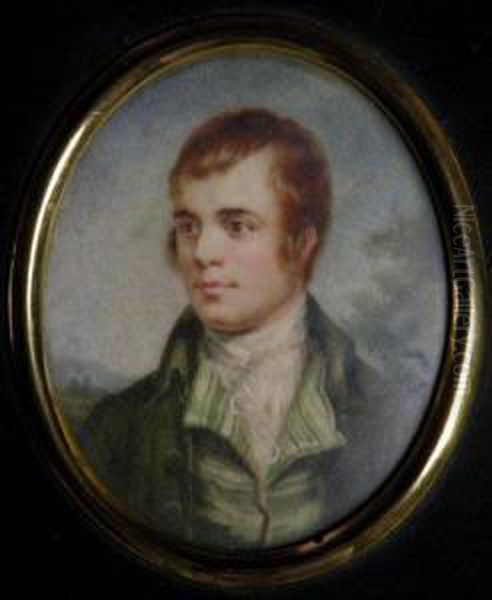
Recognizing Nasmyth's promise, Allan Ramsay invited him to London in 1774. This move offered an unparalleled opportunity for the young artist to immerse himself in the sophisticated metropolitan art world and learn directly from one of Britain's leading portraitists. Nasmyth spent approximately four years working in Ramsay's studio. His duties would have involved the typical tasks of a studio assistant: grinding pigments, preparing canvases, painting drapery and backgrounds, and potentially making copies of Ramsay's portraits for clients.
This period was crucial for Nasmyth's technical development. He absorbed Ramsay's elegant, refined style, characterized by sensitive characterization and a smooth, accomplished technique. Working within a busy and successful studio exposed him to the business side of art and the demands of high-profile patronage. London also offered access to collections and exhibitions, broadening his artistic horizons beyond what was available in Edinburgh at the time. Though primarily focused on portraiture under Ramsay, the experience provided a solid foundation in drawing, composition, and paint handling that would serve him throughout his diverse career.
Return to Edinburgh and the Italian Journey
In 1778, Nasmyth returned to his native Edinburgh, equipped with the skills and experience gained in London. He set himself up as a portrait painter, seeking to establish his own practice. His connections and talent soon brought him commissions. A key figure in his early independent career was Patrick Miller of Dalswinton. Miller was a wealthy banker, landowner, and inventor, known for his experiments with steam navigation (in which Nasmyth reportedly assisted with drawings).
Recognizing Nasmyth's potential and perhaps desiring an artist who could document his estates and family, Miller became a significant patron. Crucially, Miller provided Nasmyth with a loan or financial assistance that enabled him to travel to Italy in 1782. This two-year sojourn was a vital stage in his artistic development, particularly for his later landscape work. In Italy, Nasmyth immersed himself in the study of classical art and architecture, and, significantly, the landscapes that had inspired masters like Claude Lorrain. The clarity of Italian light and the picturesque scenery profoundly influenced his vision, encouraging a greater focus on landscape elements even within his portraiture, and laying the groundwork for his eventual specialization.
Nasmyth the Portrait Painter: Success and Politics
Upon his return from Italy around 1784, Nasmyth resumed his career in Edinburgh, primarily as a portraitist. He achieved considerable success, painting many prominent figures within Scottish society. His style, refined by his London training and Italian studies, offered a compelling alternative to contemporaries like Sir Henry Raeburn, though Raeburn would ultimately dominate the field in Edinburgh. Nasmyth's portraits from this period often incorporated landscape backgrounds, hinting at his growing interest in the genre.
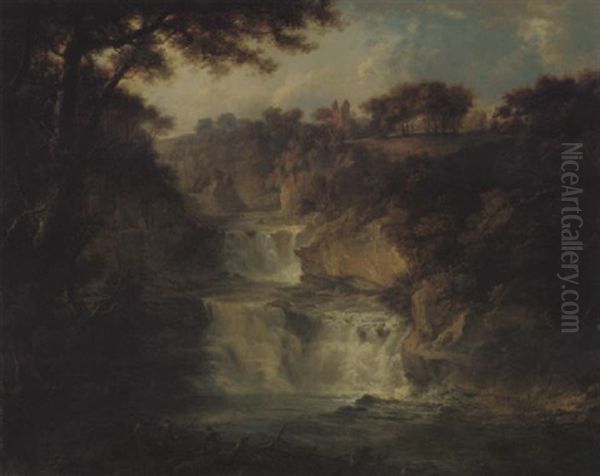
His most famous portrait is undoubtedly that of the poet Robert Burns, painted in 1787. Nasmyth and Burns were friends, moving in similar liberal intellectual circles in Edinburgh. The portrait, commissioned by the publisher William Creech, is considered the most authentic likeness of the poet. It is a relatively small, intimate work, capturing Burns's direct gaze and thoughtful expression. Nasmyth later painted copies and variations, and the image became iconic, widely reproduced through engravings.
However, Nasmyth's strong liberal and reformist political views, sympathetic to the ideals of the French Revolution, began to hinder his portrait career. Scotland's establishment, particularly the landed aristocracy who formed the core of portrait patronage, grew increasingly conservative and wary of radicalism. Nasmyth's outspokenness allegedly led to a decline in commissions from these quarters, prompting him to diversify his artistic activities and increasingly turn towards landscape painting, where political affiliations were less likely to be a barrier.
The Shift Towards Landscape Painting
The gradual move away from portraiture towards landscape painting marked a defining shift in Nasmyth's career. While political factors played a role, it's likely that his genuine passion for depicting scenery, nurtured during his time in Italy and evident even in his portrait backgrounds, was a primary driver. The market for landscape painting was also growing, fueled by the burgeoning interest in tourism, the Picturesque movement, and a developing sense of national identity tied to Scotland's unique scenery.
Nasmyth found that landscape offered a different kind of artistic fulfillment. It allowed him to explore the effects of light and atmosphere, to engage with the specific topography of his homeland, and to create compositions that blended natural beauty with human elements like castles, bridges, and country houses. He began accepting commissions to paint views of clients' estates, a practice that combined topographical accuracy with artistic composition. This transition was not abrupt but evolved over time, with landscape eventually becoming the main focus of his output and the foundation of his lasting reputation.
The Landscape Style of Alexander Nasmyth
Alexander Nasmyth's landscape style is characterized by clarity, careful composition, and a deep affection for the Scottish scene. He is often seen as bridging the gap between the idealized, classical landscapes of artists like Claude Lorrain and the more naturalistic approach of 17th-century Dutch painters such as Jacob van Ruisdael and Meindert Hobbema. His Italian journey instilled a love for balanced compositions and the play of light, often seen in his use of framing trees or architectural elements and his attention to atmospheric perspective.
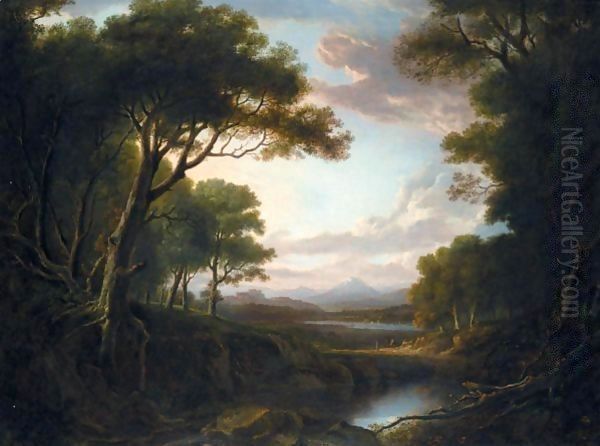
From the Dutch masters, he likely drew inspiration for detailed observation of nature, particularly in the rendering of trees, water, and cloud formations. However, his work generally avoids the dramatic intensity or rugged wildness sometimes found in Ruisdael, favouring instead a more serene and ordered vision of nature. His paintings often depict specific, recognizable locations – views of Edinburgh, the Clyde Valley, Highland lochs, or country estates – rendered with considerable topographical accuracy, fulfilling the needs of patrons who wanted records of their property or favourite views.
Nasmyth's technique involved meticulous drawing and carefully controlled brushwork. He paid great attention to the structure of the land and the way light defined form. While his colours are generally naturalistic and harmonious, his work sometimes lacks the bolder handling or heightened emotionalism that would characterize the later Romantic landscapes of artists like J.M.W. Turner. His unique contribution lies in his ability to synthesize classical composition with detailed observation of Scottish topography, creating landscapes that were both aesthetically pleasing and geographically specific, effectively establishing a national school of landscape painting.
Representative Works: Capturing Scotland
Nasmyth's extensive output includes several works that are considered representative of his style and importance. Beyond the iconic Portrait of Robert Burns (c. 1787, Scottish National Portrait Gallery), his landscapes define his legacy.
The Falls of Clyde (various versions, e.g., c. 1810-20, National Galleries of Scotland) depicts a popular subject for artists exploring the sublime and picturesque aspects of Scottish scenery. Nasmyth captures the power of the waterfalls (Corra Linn or Bonnington Linn) set within a dramatic wooded gorge. His treatment balances the wildness of the scene with a sense of compositional order, often including figures admiring the view, emphasizing the human experience of nature's grandeur.
Views of Edinburgh were a recurring theme. Edinburgh from Calton Hill (e.g., c. 1825, National Galleries of Scotland) showcases his skill in panoramic cityscapes. He meticulously renders the city's landmarks, including the castle, Holyrood Palace, and the developing New Town, under a broad sky, capturing the unique interplay of architecture and dramatic natural setting that defines Scotland's capital. These views celebrate the city during a period of significant growth and intellectual ferment.
His paintings of country houses and estates, often commissioned by landowners, demonstrate his ability to combine topographical accuracy with picturesque composition. Works like A View of Tantallon Castle with the Bass Rock (c. 1816) show his interest in historical sites integrated into the landscape, blending natural beauty with romantic associations of the past. These diverse examples highlight Nasmyth's role in shaping how Scotland's landscapes and cityscapes were perceived and represented.
Nasmyth as Teacher and Mentor: Shaping a Generation
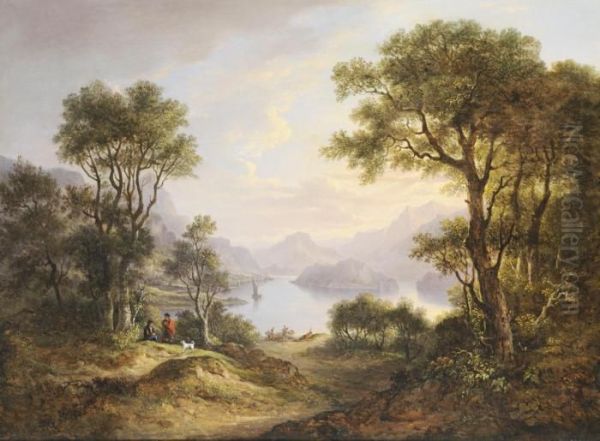
Alexander Nasmyth's influence extended significantly through his role as an educator. Faced with declining portrait commissions, he established a successful private art school at his home in York Place, Edinburgh, around 1798. He taught drawing and painting, primarily focusing on landscape, to a wide range of students, including aspiring professionals and amateur enthusiasts, many from affluent families. His teaching methods emphasized direct observation of nature, sketching outdoors, and understanding the principles of perspective and composition.
He nurtured a remarkable number of artists who went on to achieve significant recognition. His most famous pupil was arguably Sir David Wilkie, renowned for his genre scenes, who acknowledged Nasmyth's foundational influence. Other prominent students included the landscape and marine painter Clarkson Stanfield, the architectural and topographical painter David Roberts (famous for his views of the Near East), the historical painter Sir William Allan (later President of the Royal Scottish Academy), the Reverend John Thomson of Duddingston (a highly regarded amateur landscape painter), Andrew Wilson (landscape painter and later master of the Trustees' Academy), and Hugh 'Grecian' Williams (known for his watercolours of Greece). Nasmyth's guidance helped shape the direction of Scottish art in the early 19th century, solidifying the landscape tradition he had pioneered.
Beyond Painting: Engineering, Architecture, and Theatre
Nasmyth's inquiring mind and practical skills, perhaps inherited from his builder father, led him to engage actively in fields beyond painting. He possessed considerable talent for mechanical drawing and invention, reflecting the spirit of practical innovation prevalent during the Scottish Enlightenment. He is credited with assisting his patron Patrick Miller with drawings for Miller's early steamboat experiments on Dalswinton Loch in 1788.
In architecture and engineering, Nasmyth contributed designs for several projects. He designed the elegant neo-classical temple covering St Bernard's Well by the Water of Leith in Edinburgh (1789). He was involved in proposals for the development of Edinburgh's New Town and is credited with suggesting the cylindrical form for the Dean Bridge piers, designed by Thomas Telford, to harmonize with the well structure downstream. He also invented a type of "bow-and-string" arched bridge construction and developed new methods for riveting. While not all his engineering ideas were realized, often due to cost, they demonstrate his versatility and engagement with the practical challenges of his time.
Furthermore, Nasmyth applied his artistic skills to the theatre, designing stage sets for productions in Edinburgh and Glasgow. This work required an understanding of perspective, illusion, and dramatic effect, complementing his landscape painting. His involvement in these diverse fields underscores his position as a figure whose interests bridged the arts and sciences.
The Nasmyth Family: An Artistic Dynasty
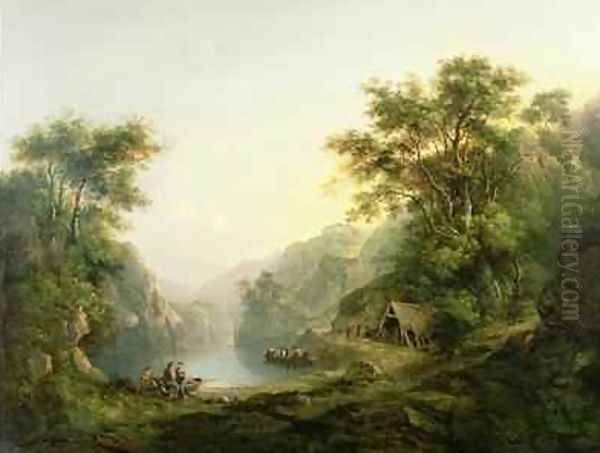
Alexander Nasmyth was the patriarch of a remarkably talented family. He married Barbara Foulis in 1786, and together they had a large family, including six daughters – Jane, Barbara, Margaret, Elizabeth, Anne, and Charlotte – and two sons, Patrick and James. Artistry ran strongly through the family; Alexander taught his children, and the daughters became accomplished painters and art teachers in their own right. They assisted their father in his teaching practice, which became a family enterprise, offering instruction particularly to ladies in drawing and painting. Their collective output contributed significantly to the artistic life of Edinburgh.
His eldest son, Patrick Nasmyth (1787-1831), became a highly successful landscape painter, often called the "English Hobbema" due to his detailed, naturalistic style influenced by Dutch masters. He worked mainly in London and achieved considerable fame, though his style differed somewhat from his father's broader, more classically inspired approach.
The youngest son, James Nasmyth (1808-1890), achieved international renown not as an artist (though he was a skilled draughtsman and photographer) but as an engineer and inventor, most famously of the steam hammer. James's autobiography provides valuable insights into his father's life, character, and methods. The Nasmyth family thus represents an extraordinary confluence of artistic and technical talent spanning two generations.
Later Life and Enduring Legacy
Alexander Nasmyth remained active as an artist and teacher well into his later years. He was a respected figure in Edinburgh's cultural life, known for his genial character and wide-ranging knowledge. He was involved in the founding of various artistic societies, including the Society of Associated Artists, and was made an honorary member of the nascent Royal Scottish Academy. His home in York Place was a hub of artistic activity and intellectual exchange.
He continued to paint Scottish landscapes, fulfilling commissions and exhibiting his work. His style remained largely consistent, characterized by its clarity, topographical interest, and harmonious composition. He died in Edinburgh on April 10, 1840, at the advanced age of 81, and was buried in St Cuthbert's Kirkyard.
His legacy is multifaceted. As the "Father of Scottish Landscape Painting," he effectively established the genre as a distinct and respected tradition within Scottish art. His influence was profound, both through his own works, which celebrated the beauty and character of Scotland, and through his teaching, which shaped a generation of successful artists, including figures like Wilkie, Roberts, and Stanfield. His ability to blend artistic sensitivity with practical ingenuity in engineering and design marks him as a quintessential figure of the Scottish Enlightenment. His works remain highly regarded and are held in major collections in Scotland and beyond, ensuring his enduring importance in the history of British art.
Conclusion: A Cornerstone of Scottish Art

Alexander Nasmyth's contribution to Scottish culture extends far beyond his famous title. He was more than just the "Father of Scottish Landscape Painting"; he was a versatile artist, an influential teacher, an ingenious designer, and a figure deeply embedded in the intellectual life of the Scottish Enlightenment. From his early training under Allan Ramsay to his formative journey through Italy, his career evolved from successful portraiture, including the definitive image of Robert Burns, to a profound engagement with the landscapes of his homeland. His carefully composed and detailed views of Scotland's scenery, cities, and estates established a national artistic identity. Through his teaching, he directly influenced a generation of artists, including luminaries like Sir David Wilkie and David Roberts, ensuring the continuation of the landscape tradition he pioneered. His ventures into architecture and engineering further highlight his diverse talents. Alexander Nasmyth remains a cornerstone of Scottish art history, a testament to the rich interplay of art, nature, and innovation in late 18th and early 19th-century Britain.